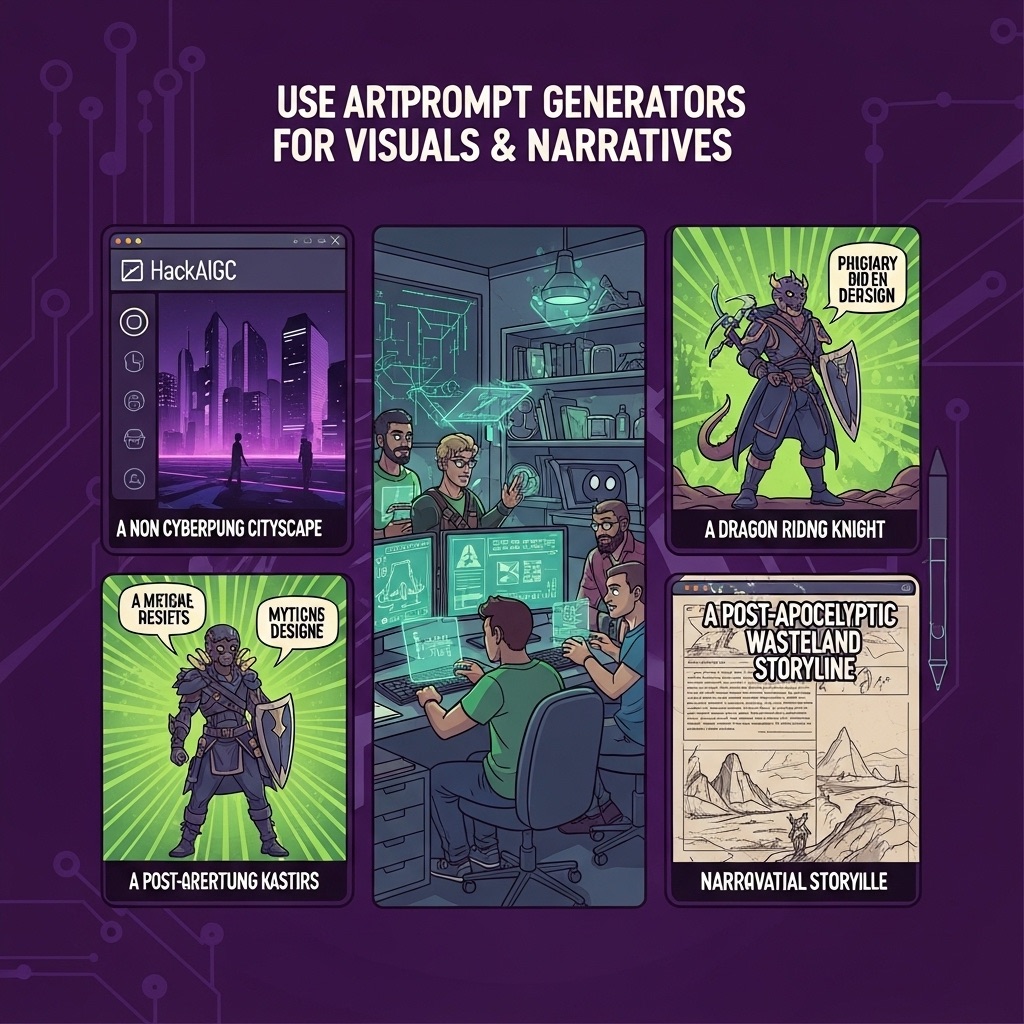- Latest News about Uncensored AI
- How Art Prompt Generators Power Game Design
How Art Prompt Generators Power Game Design
Game design thrives on creativity, blending stunning visuals with compelling narratives to create immersive worlds. An art prompt generator is revolutionizing this process by providing game developers with instant, tailored ideas for concept art and storylines. In 2025, tools like HackAIGC empower designers to craft unique game assets and narratives, streamlining workflows while ensuring privacy and high-quality outputs. This guide explores how AI art prompt tools enhance game design, offering practical steps, tips, and insights into their future in the gaming industry.
Why Art Prompt Generators Are Game-Changers for Game Design
Bridging Art and Storytelling in Games
An art prompt generator bridges visual art and narrative creation, two pillars of game design. For example, a prompt like “A cyberpunk cityscape with neon-lit skyscrapers” can inspire both a game’s visual aesthetic and its storyline. Tools like HackAIGC provide AI-driven game visuals that spark ideas for environments, characters, and plot points. X posts from game designers highlight the value of AI art for games, noting how these tools reduce creative blocks and accelerate ideation, making them essential for modern game development.
Benefits for Game Developers
Using an art prompt generator offers game developers significant advantages:
Speed: Generate ideas for concept art or storylines in seconds, cutting pre-production time.
Diversity: Access prompts across genres, from fantasy to sci-fi, ensuring varied game assets.
Collaboration: Share prompts with team members to align artistic and narrative visions. HackAIGC’s game design prompts support these benefits, with customizable outputs tailored to game development needs. X feedback praises its ability to deliver AI-driven art ideas, helping developers create cohesive, immersive game worlds.

Using Art Prompt Generators for Game Visuals and Narratives
Creating Concept Art with AI Prompts
Concept art sets the visual tone for games, from character designs to world environments. An art prompt generator like HackAIGC can generate prompts such as “A steampunk airship docked in a misty harbor” to inspire artists. By inputting specific details (e.g., “dark fantasy, muted colors”), designers receive concept art AI tools outputs that align with their game’s aesthetic. X reviews commend HackAIGC’s multi-modal support, which pairs text prompts with visual references, streamlining the concept art process for game studios.
Crafting Game Storylines with Prompts
Beyond visuals, art prompt generators inspire game narratives. For instance, a prompt like “A rogue AI controlling a futuristic city” can spark a storyline about rebellion and technology. HackAIGC’s game narrative generators allow writers to refine prompts for specific genres, ensuring cohesive plots. X users note its ability to produce AI-driven art ideas that integrate seamlessly with narrative development, enabling writers to craft engaging stories that complement a game’s visual style.
HackAIGC’s Multi-Modal Support
HackAIGC stands out as a leading art prompt generator for game design, offering multi-modal support for both text and image prompts. Designers can generate a text prompt like “A post-apocalyptic wasteland with glowing ruins” and receive a corresponding visual reference, enhancing workflow efficiency. With 99.9% uptime and robust privacy features, as praised in X feedback, HackAIGC ensures AI art for games is secure and reliable. Its intuitive interface makes it accessible for both artists and writers, fostering creative synergy in game development.
Practical Tips for Game Designers
Optimizing Prompts for Game Assets
To maximize an art prompt generator for game design, optimize prompts for clarity and specificity:
Define the Genre: Use terms like “sci-fi” or “medieval” to align with the game’s theme.
Specify Visual Details: Include colors, lighting, or mood (e.g., “vibrant, neon-lit cyberpunk alley”).
Iterate Outputs: Refine prompts based on initial results to match the game’s vision. HackAIGC’s creative prompt generator supports detailed customization, allowing designers to fine-tune game design prompts for precise outputs. X posts highlight its ease of use, helping teams create assets that align with project goals.
Integrating Prompts into Development Workflows
Integrating art inspiration software into game development workflows enhances efficiency:
Concept Phase: Use prompts to brainstorm environments or characters during pre-production.
Team Collaboration: Share prompts across art and writing teams to ensure cohesive designs.
Prototyping: Generate quick visuals or story snippets to test ideas before full development. HackAIGC’s how to use art prompts guides streamline integration, with X users noting its ability to save time and foster collaboration in fast-paced game studios.
The Future of Art Prompts in Game Design
Emerging AI Trends for Games
In 2025, art prompt generators are evolving to meet game design demands. Trends include:
Real-Time Collaboration: AI tools enabling artists and writers to co-create in shared spaces.
VR Integration: Prompts generating assets for virtual reality games, enhancing immersion.
Adaptive AI: Tools tailoring prompts to specific game genres or team workflows. X discussions predict these trends will redefine game development, with AI art trends 2025 emphasizing efficiency and creativity. HackAIGC is poised to lead, with updates supporting collaborative and VR-compatible prompts (X post, July 12, 2025).
HackAIGC’s Role in Game Innovation
HackAIGC is a frontrunner in innovative art tools, offering game designers a versatile platform for visual and narrative creation. Its privacy-first approach ensures secure data handling, critical for collaborative projects, while its multi-modal capabilities support AI creativity solutions. X feedback praises its reliability and customization, making it ideal for game studios seeking to innovate. As the gaming industry embraces AI, HackAIGC’s art prompt technology empowers developers to create groundbreaking games in 2025.
